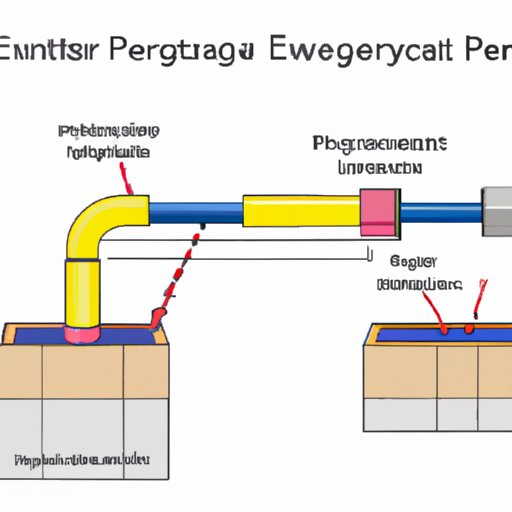Introduction
Potential energy is a fundamental concept in physics that has a significant impact on our daily lives. From the boulder on top of a hill to the food in our fridge, everything has potential energy waiting to be converted into kinetic energy. The purpose of this article is to explain the concept of potential energy, its different types, provide real-life examples, and illustrate its transformation into kinetic energy. This article targets individuals who want to grasp a clear understanding of potential energy at a beginner’s level.
Understanding Potential Energy
Potential energy is the energy that an object possesses due to its position or condition. It is the energy that an object has stored until it gets released. Objects with high potential energy have the potential to do work since they can convert potential energy into kinetic energy.
The difference between potential energy and kinetic energy is in their basic definitions. Potential energy is the stored energy in an object or system, whereas kinetic energy is the energy that comes from motion. A perfect example that can illustrate the difference between potential and kinetic energy is the falling object. A baseball on top of a building has potential energy, which turns into kinetic energy as it falls from the building to the ground.
Everyday Objects and Potential Energy
Potential energy is all around us, and it comes in different shapes and sizes. Most of the everyday objects we come into contact with have potential energy stored in them. An excellent example of potential energy is the stretched rubber band. When stretched, the rubber band stores potential energy that is released when the band snaps back to its original form. Springs, batteries, and water in a dam are other everyday objects with potential energy.
Objects with potential energy can convert this energy into kinetic energy when stimulated by an external force. Suppose a spring is stretched and then released. In that case, it will convert the potential energy stored in the spring into kinetic energy, which will bring movement to the object.
Different Types of Potential Energy
There are three main types of potential energy –gravitational, elastic, and electric potential energy.
Gravitational potential energy is stored due to an object’s position concerning the earth’s gravitational force. An object’s gravitational potential energy can be calculated using the formula mgh, where m is the mass of the object, g is the acceleration due to gravity, and h is the height of the object. This type of potential energy is found in objects like rocks, boulders, and even our bodies.
Elastic Potential Energy is the energy stored in an object when work has been done on it to change its shape. The elastic potential energy formula is 0.5ke^2, where K is the spring constant and e is the displacement from its equilibrium position. An excellent example of an object with elastic potential energy is the stretched rubber band or spring.
Electric potential energy is the electrostatic energy stored between the charged particles. It is the energy that a charged object possesses in a particular position relative to other charged objects. This energy type is crucial in electrical systems such as charging batteries or capacitors.
Comparison of Potential and Kinetic Energy
Potential energy is stored energy that can convert into kinetic energy. Kinetic energy is energy in motion, and it has the ability to do work on other objects. Both types of energy are essential and compliment each other in action. Objects with high potential energy have the capability of releasing energy hence affecting its surrounding environment. A steam engine is an excellent example of potential energy conversion to kinetic energy. The boiling water stored in the engine has potential energy, which converts to kinetic energy, resulting in the train’s movement.
Potential Energy in Different Fields
The concept of potential energy is fundamental in various fields such as mechanics, physics, and biology. In physics, potential energy is critical in studying the dynamics of machines and systems. In mechanics, it is necessary in helping us understand the forces of equilibrium and stability. In biology, it is essential in learning about the energy sources necessary for living organisms to thrive and survive.
Interesting Examples of Potential Energy
There are fascinating examples of potential energy from around the world. One is the hydroelectric power plant at the Hoover Dam in the United States. Water stored in the dam has gravitational potential energy, which converts to kinetic energy, powering turbines that generate electricity for millions of people.
Another example is the ancient Inca City of Ollantaytambo. The city’s design incorporated water channels that harvested the gravitational potential energy of running water from the surrounding mountains. The energy was used to irrigate fields and power mills in the town.
Transformation of Potential Energy into Kinetic Energy
Potential energy can be transformed into kinetic energy by providing an external force. When the external force acts on an object, it releases the potential energy stored in the object. The transformation of potential to kinetic energy is affected by different factors, including mass, height, and gravitational force. An object’s mass has an inverse relationship with its height when calculating potential energy. The higher the object, the more potential energy it has and the more kinetic energy it can release when stimulated.
Conclusion
Potential energy is an essential concept in physics that we use daily. Understanding potential energy enables us to have a better understanding of how things work and how energy conversion is essential in our daily routine. The concept of potential energy paves the way for us to comprehend more complicated laws of motion and energy dynamics that govern the universe.
